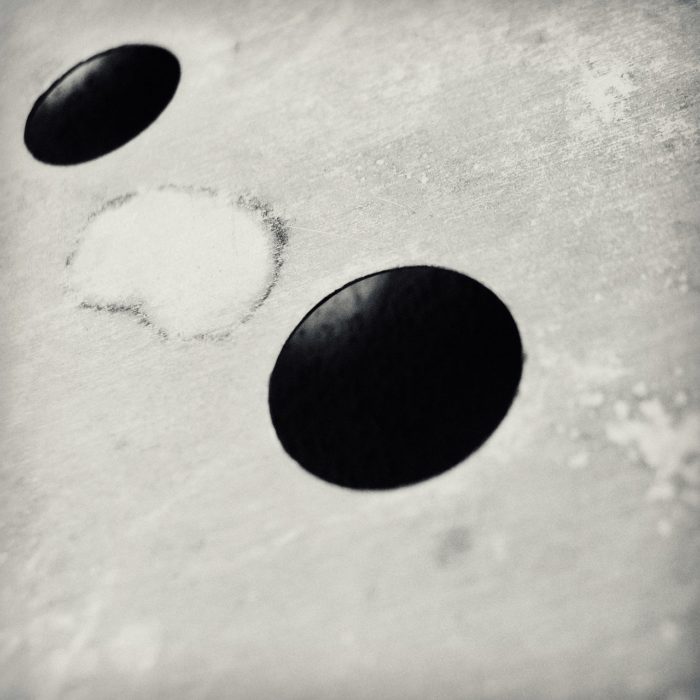Iranian composer Porya Hatami joins the ranks of the Line roster for Monads. The album collects a variety of sound experiments and excursions that are largely devoid of melody or obvious rhythm. Instead, each track is its own self-contained sonic world, all built from real-time single track synth manipulations. As a result, Monads is best considered as a universe of independently orbiting planets, each one fairly different from the next while still feeling loosely unified by Hatami’s approach. But gone completely are the more melodic or environmental sounds of his past releases, replaced by often bone dry acoustics and writhing signals. “1B (Fold)” is downright sublime, though, probably my favorite of the series. Its undulating waveforms and interval oscillations give it a woozy calm that recalls mid-90s Oval. “3B” has a similar sort of calm undulation in its low end, which gives it a downright physical quality on headphones, felt as much as heard.
Elsewhere, “4 (Phonetic)” begins with a whisper and gets only quieter from there, bringing to mind some of the more minimal and severe moments of the early Line catalog, perfect for quiet, still evenings. For each of its more gliding and serene tracks, there is a complement like “3C,” which sounds like a strange alien atmosphere, bristling with electricity. “6B (of Presence)” is a flurry of signal while closing cut “8 (Kurdish Folk Song)” is almost painfully gorgeous, its lonely synth reverberating in a dry, cavernous space. While its lack of any obvious melody might eke it further left of center, I find the curiosity and ingenuity of Hatami’s excursions inspired and exciting. Highly recommended for fans of experimental synth music in the vein of Rashad Becker or Florian Hecker.
(earinfluxion.com)
+
Porya’s new album, Monads (LINE), might be his most hypnotic effort to date, despite seeing him leave behind his previous focus on melodic ambient composition in favour of a work fitting the microsound focus of the LINE imprint. I’m often fairly ambivalent about work that fits in this category – “ambient glitch” for want of a better term – but this definitely resides in the upper tier of the style.
(drownedinsound.com)
+
Porya Hatami (from Iran) has released quite an array of albums since 2012, and this is his debut for the LINE label. Compared to his earlier releases, Monads is more abstract and experimental in sound design (which in fact perfectly fits the label).
Monad is a philosophical concept referring (in this case) to ‘elemental particles of nature; basic elements of perceptual reality.’
These (twelve) tracks are presented as Monads, which is to say they ‘neglect to follow structure or narrative.’ Each track is a single entity (maintaining ‘a harmonious distance from each other with no open window for communication’)
It’s like listening to a few minutes of sound taken from a stream that has neither beginning nor end—a stream that simply ‘is’. Yet was unheard by many, until Hatami unlocked the hidden dimensions and found a way to collect these sonic fractals for us to enjoy.
(ambientblog.net)
+
Here is the mystery of Monads. It is, by design, not an album of tunes, or even of nice, appealing drones. It is a collection of experiments in sound design, playing with frequencies and the odd bulges, strange eruptions, and frayed edges that emerge when sound itself is subjected to expert duress. It appears on the LINE label, which specializes in rarified noises that would puzzle many of my friends. It is an album that, save for one track, might be a shock to the system of anyone who comes to it from the melodic, pastoral beauty of a previous Hatami album such as Shallow. It is the kind of album where the review ought to be about all the special equipment and arcane techniques employed to wrestle the novel sounds out of the ether.
And yet….and yet it remains strangely musical, an album to which I find myself returning more than I thought I might. It evokes an enduring fascination. And that gets me wondering again what it is about recordings that most of my relatives would not concede to be music that nevertheless draws me in.
It helps that the sounds, odd, abstract, and alienated as they are, are never grating. The tonalities generated are varied, organic, and interesting and often in their own way winsome and tuneful, like an alien orchestra making music that escapes our cultural horizons. The soundscape is strange, but not creepy – only 7 (Verblendungszusammenhang) sounds anxious. (At least to my ear; I have learned that the threshold of other family members can differ from mine.) 8 (Kurdish Folk Song) is rather beautiful in texture and indeed somewhat song-like, provided the song is sung by space whales in the subterranean oceans of a moon orbiting Jupiter. It leaves me with a sense of wonder. The first key, then, is just to listen with attentive and open ears to the sounds themselves as they prance and swoop and loom, and to enjoy the specific pleasure of their textures, even as they sound like nothing at all but themselves.
And then, along with the textures, there is the ongoing sense of churning, wandering movement. There are, no beats or regular rhythms, yet nothing is still and the nature of the movement keeps shifting not only between, but within tracks. Take 3A, a track that burbles forcefully with barely audible deep frequencies and bubbles insistently with a kind of turbulent air pressure. There is indeed no narrative, but there is a sense of life, of urgency, of something stirring in the depths. The next track, 3B, keeps a murmur of the deep but shifts the focus into the buzzing air, stuttering firefly-like over a calming hum as odd whistles swoop in obscure squiggles. The background of hiss of 4 (Phonetic) reminds me of a river heard in the middle distance, but in the foreground percussive gusts swirl; after a while a rather train-like rhythm appears, and deforms, and vanishes again, too brief and abstracted to seem referential, yet nevertheless a moment where something familiar-seeming rises from the mist. The opening turbulence of 6A might sit somewhere between the howling of winds and of creatures, yet the closing section feels more like a lap steel guitar played by zephyrs.
I do not mean to suggest that the album is programmatic, or to impose my own mind’s groping for this-worldly points of reference onto the material. I do not at all have the impression that the sounds are actually meant to paint objects in the world. And yet in their laying bare of primal sonic layers they at times feel like archetypes, evocations of a kind of basic energy trying to take form, evocations that speak of the ways that such energy swirls or buffets, howls or hums, looms or stutters in the fabric of reality. And in this sense the various sounds do feel to me rooted in the world. I am left thinking that if the album is about anything it is about the glories to be found in sound itself, in the myriad ways that energy can move through molecules and make beauty, ways hardly exhausted by all the more conventional tunes ever written.
Released back in April, Monads is not the most accessible Porya Hatami recording, but it may be one of his best.
(musicisgood.org)


